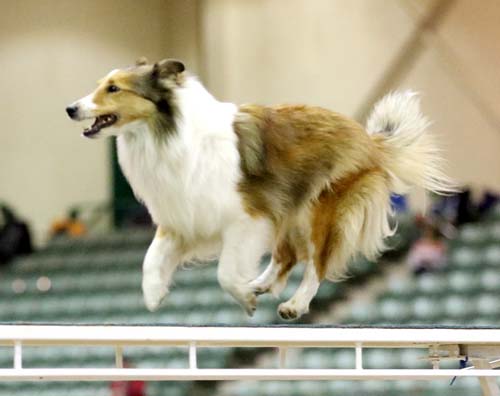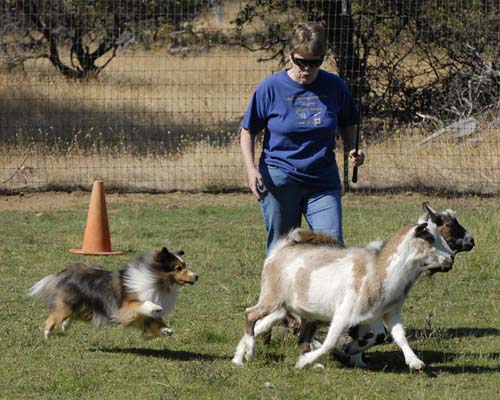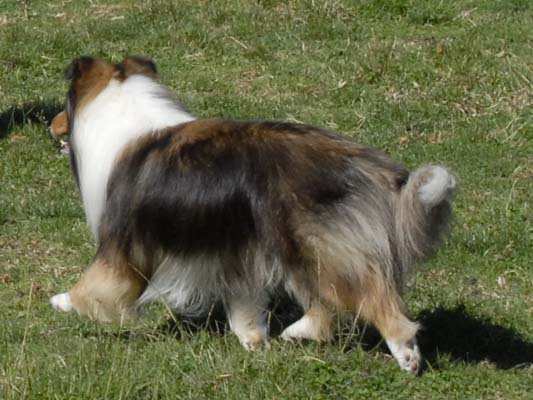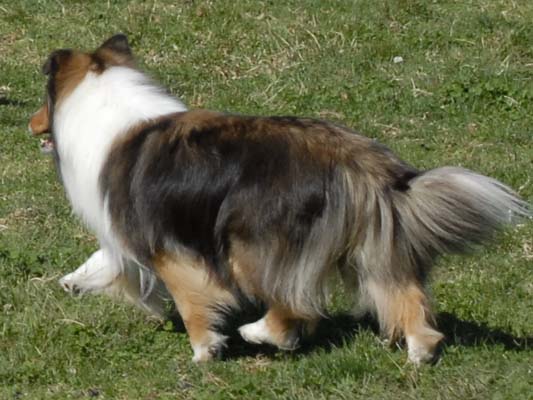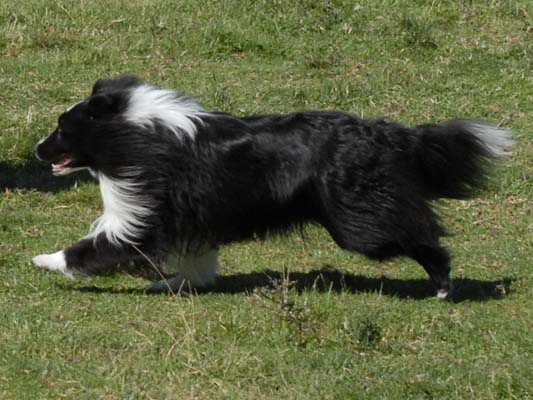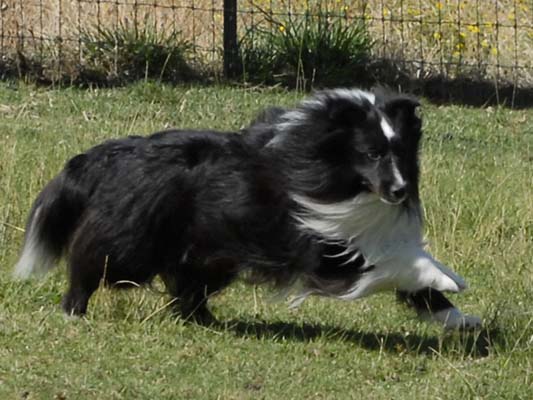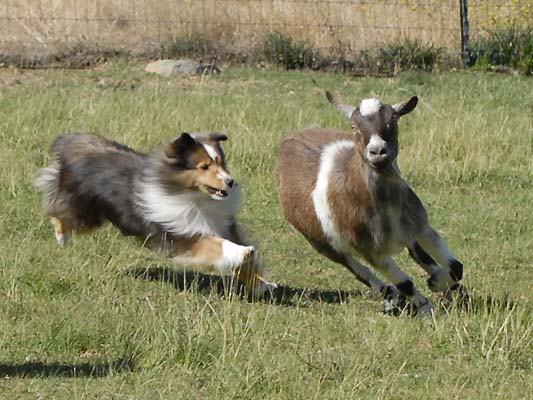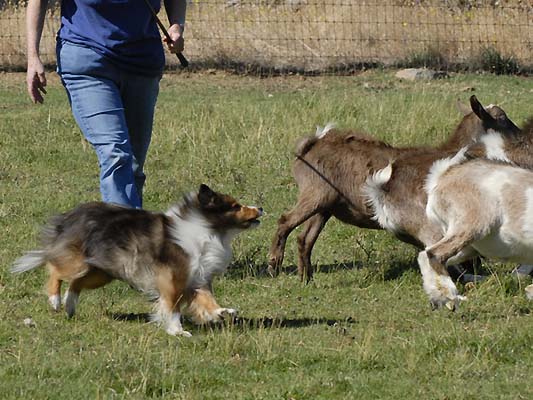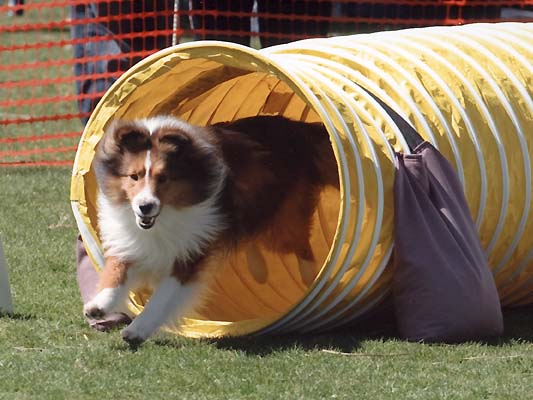|
|
 Reg
Where performance counts!
|
|
|
Symmetrical Dog Gaits:
Dog gaits can be divided into symmetrical and asymmetrical gaits. In symmetrical gaits, such as
the walk, trot and pace, the left legs move with exactly the same timing and
footfall order as do the right legs. To put it another way, in the pace the left legs move and then the right
legs move. In the trot the left front and right rear legs legs move together and then the right front and left rear legs move in exactly the same way. There is no leading leg in symmetrical gaits.
An excellent web page with animations and footfalls of the various dog gaits can be found at the
University of Minnesota Veterinary College web site.
|
Symmetrical Gait: Janelle
Trotting
The position of the left legs
in the first photo is the same as the position of the right legs in the
second photo.
The position of the right legs in the first photo is the same as
the position of the left legs in the second photo.
|
|
|
|
|
|
Asymmetrical Dog Gaits:
In asymmetrical
gaits, which are the canter and gallop, the rear legs move and
then the front legs move. The movement and timing patterns of
footfalls are different on the left and right. Dogs can do
both a rotary and a transverse gallop, which differ in the
pattern of the footfalls. The rotary gallop is the faster
of the two. Refer back to the
University of Minnesota Veterinary College web site for the
footfalls and animations of canters and gallops.
|
Asymmetrical Gait: Galloping
The positions of the left legs
will never be repeated in the right legs–until the dog changes
leads.
Every
gallop in the dog has at least one period of suspension
with all four legs off the ground.
This occurs when all four legs
are collected under the dog.
|
|
| |
| |
Sally demonstrates her
first (and possibly only) suspension period in the
gallop, while running across the agility dog walk.
|
|
Asymmetrical Gait: Double Suspension Gallop
A properly motivated, well-built Sheltie is perfectly capable of
a double suspension gallop,
with the second suspension period coming
when the dog's legs are in full extension.
|
|
| |
| |
Janelle, above, demonstrates proper motivation
for the fast-paced double suspension gallop, on her right lead.
The second period of suspension, shown above, occurs when the
legs are extended.
|
|
Asymmetrical Gait: The Lead Leg
In
the canter and gallop, the dog can run with his footfalls in either of two mirror images, referred
to as the right and left leads. The leading leg is whichever front leg
reaches the farthest forward. The
lead leg bears the dog’s weight longer that does the opposite foreleg.
|
Asymmetrical Gait: Bret On His Left And Right Leads
The two
leads have footfall patterns which are mirror images of each
other.
Bret is slightly farther along in his stride in the left lead
photo than in the right lead photo.
|
|
|
|
|
|
|
The Left Lead
When the dog is on the left lead, the
right foreleg hits the ground before the left
foreleg. The left foreleg hits the ground
in front of the right foreleg.
|
|
The Right Lead
When the dog is on the right lead,
the left foreleg hits the ground before the
right foreleg. The right foreleg hits the
ground in front of the left foreleg. |
|
When Does Lead Matter?
On a straight run, the dog may use either lead, and may change
leads in mid-stride. Many dogs have a preference for one lead
over the other. When the dog is running in a curve or circle, it
is important that he or she use the correct lead, and most will
do so automatically. The inside lead on a curve will be the most
effective and balanced way for him or her to run. In general,
the dog will run on the right lead when going clockwise, and on
the left lead when going counterclockwise.
|
|
Lead doesn't matter when the dog is
running straight.
The video
Slow
Motion Dog Run on YouTube shows a dog running
a double suspension gallop in slow motion on a
straight course.
He switches from right to left lead about two thirds of the way
through the video.
Can you see the switch?
|
|
|
|
|
|
|
Clockwise on the Right
Lead |
|
Counterclockwise On The
Left Lead |
|
Switching Leads:
Dressage horses learn to change leads in
response to leg and rein cues from a rider. Dogs learn to
change leads in response to verbal cues and the handler’s
body language. Most dogs have a preferred lead, but learn
to switch leads on cue.
In sheep herding, the cues will be the “Come by (or “Go by”)
and “Away to me” commands. In agility, the verbal cues will
be “Turn” or “Switch”, and more importantly, the body
English that tells the dog where the handler is heading
next. The musher uses “Gee” and “Haw”. In
general, commands that
signal right or left turns will cue the dog to switch leads
if he is not already on the correct lead for the upcoming
curve.
|
When the Left Lead is Right and the Right Lead is Wrong:
A dog who is trying to circling sheep on the wrong lead is
likely to spin out away from the stock, a big no-no in sheep
herding. An agility dog on the wrong lead is far more likely to
knock down a jump bar, to back jump, to spin as she lands after a
jump, or to take an incorrect obstacle. An obedience dog who
goes over a jump on her right lead for a dumbbell on her left is
more likely to spin or curve around before she goes to the
dumbbell.
Reasons for the dog being on the wrong lead
include:
- Handler miscue.
- Inexperienced dog misreads a cue.
- Distracted dog fails to see the cue.
- Strongly left or right handed dog fails to respond to the cue.
- Subtle lameness that makes one of the leads uncomfortable or
painful.
|
|
Is Dustin On The Wrong Lead?
He certainly appears to be! He
looks like he's trying to head counter-clockwise on that
right lead. He was much younger and
less experienced then, and could have been late with a
lead switch. This was also his first run after a
knee injury several months earlier. And it's possible that I had cued him a switch and
he's about to turn to his right (and just happens to
be watching the photographer). But if he continues
on the counterclockwise curve,
he will switch
leads in the next stride.
|
A Bibliography of Dog Movement:
Publications:
-
Animals In Motion, Eadweard Muybridge,
1957, Dover Publications. Available from
Amazon.
This contains a selection of plates from the eleven volume
work, Animal Locomotion, published in 1887. These were
the first rapid series still photographs of moving animals.
-
Dog Locomotion and Gait Analysis, Curtis M Brown, 1986, Hoflin Publishing Company.
A comprehensive and technical look at the gaits of the dog,
and their variations among breeds.
-
Dogsteps - A New Look, 3rd Edition, Rachel Page Elliott,
2009, Fancy Publications. Available from
Dogwise.
Revised edition
of a classic book on the evaluation of movement and gait
designed for dog fanciers.
-
How Mammals Run:
Anatomical Adaptations, P. P. Gambaryan, Transl. from
Russian by Hilary Hardin, 1984, John Wiley & Sons.
Out of print, expensive and near impossible to find, except in a library.
Video:
- Dogsteps - What To
Look For In A Dog, DVD,
Rachel Page Elliott,
2005, Dogwise Publishing. Available
from
Dogwise. The companion to the book, the DVD includes
anatomical diagrams and film clips of still and moving
x-rays showing bone and joint motion inside the dog. The DVD
emphasizes sound structure and shows how serious deviations
may affect efficiency and endurance.
Web Site:
-
Gait Foot-Fall Patterns - University of Minnesota
College of Veterinary Medicine. This site has animated
gait and footfalls, with a good description of each gait.
|
|
This page was
Copyright © 2008- Alicia Keegan
Free random image script provided by
JavaScript Kit |
|
 Reg
Reg 